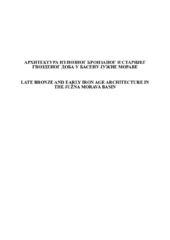Приказ основних података о документу
Архитектура бронзаног и гвозденог доба у басену Јужне Мораве
Late Bronze and Early Iron Age Architecture in the Južna Morava Basin
| dc.creator | Kapuran, Aleksandar | |
| dc.date.accessioned | 2023-07-28T12:21:01Z | |
| dc.date.available | 2023-07-28T12:21:01Z | |
| dc.date.issued | 2009 | |
| dc.identifier.isbn | 978-86-86563-66-8 | |
| dc.identifier.uri | http://rai.ai.ac.rs/handle/123456789/540 | |
| dc.description.abstract | Great migrations and invasions from the north to the south of the Balkan peninsula were causes of instability in the valleys of large rivers. The number of fortified hill fort settlements increased during the early Iron Age II because of the appearance of the Thracian-Cimmerians and the representatives of the Basarabi style, when local populations withdrew from areas that they cold not defend to less accessible, naturally protected elevations, where they started building forts. In the Velika Morava basin such forts had earthen ramparts, reinforcing wooden structures and defensive trenches. On the other hand, at particular hill forts only palisade fortifications were observed (Hisar and Končulj). | sr |
| dc.language.iso | sr | sr |
| dc.language.iso | en | sr |
| dc.publisher | Belgrade : Faculty of Philosophy, Archeological Collection | sr |
| dc.relation | info:eu-repo/grantAgreement/MESTD/Basic Research (BR or ON)/177020/RS// | sr |
| dc.rights | openAccess | sr |
| dc.subject | Central Balkans | sr |
| dc.subject | Južna Morava river basin | sr |
| dc.subject | architecture | sr |
| dc.subject | Late Bronze Age | sr |
| dc.subject | Early Iron Age | sr |
| dc.title | Архитектура бронзаног и гвозденог доба у басену Јужне Мораве | sr |
| dc.title | Late Bronze and Early Iron Age Architecture in the Južna Morava Basin | sr |
| dc.type | book | sr |
| dc.rights.license | ARR | sr |
| dc.citation.epage | 184 | |
| dc.description.other | Centar za arheološka istraživanja ; knj. 23 | sr |
| dc.identifier.fulltext | http://rai.ai.ac.rs/bitstream/id/1398/bitstream_1398.pdf | |
| dc.identifier.rcub | https://hdl.handle.net/21.15107/rcub_rai_540 | |
| dc.type.version | publishedVersion | sr |


